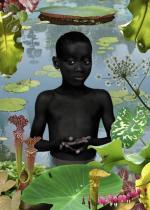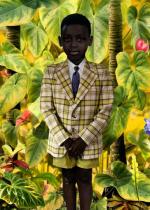The fantastic world of Ruud van Empel
RvE: To do collage is necessary for me to express my idea, as I mentioned before, I am not satisfied with taking just one picture, there are always to many imperfections, so I need to stage everything but even that is limited, and does not guarantee a perfect image.
Now in Photoshop there are new possibilities that enable me to almost reach perfection in the composition and colour, and I work with that in my own way and that is personal.
I work with my imagination and try to get that into photo-realism. absolute perfection you can not get in this technique because everything is a montage, photographed separately, so things look a bit strange, and that also gives it a personal feeling.
FB: Many of your work represents children immersed in a natural world without space and time, a forest of dreams, a paradise on earth. This is an invitation to a return to a primordial and pure state of the existence? The series “Word” suggests a kind of universality that goes beyond skin colour and borders of states. Is indeed racial tolerance another of your messages? How important are the social themes in your work?
RvE: For me it is not important, it is the same for me to use a black child as a white child, they are both innocent, there is no real difference between them, and I thought that was normal to think like that, I thought everybody thought like that and it is strange to find out that some people don’t like that I am showing dark people, I sometimes get hate-mail and such things, unbelievable!
This social theme is more big than I thought.
Fb: Can you say a few words about one of the pictures that accompany this interview?
RvE: World #20 is inspired on one of my own childhood photographs, when I was a kid I had to wear a suit with a tie and short trousers, I was supposed to look like a young gentleman but off course I only wanted to play wildly in the gardens and fields around our house.
So it is funny to see a young boy all dressed up in a suit, and I translated this to dark children in tropical forest, in detail you can see a marking on his left knee, there is a little wound from playing to wildly but for the rest he is looking as a perfect example of a nice and good child.
To read the rest of this article go to page: 1 2 3 4 5






Massimo Cristaldi
said, December 1, 2007 @ 12:12 PM :
Complimenti per l’Intervista. Bravo l’autore ed interessanti gli scatti.
Ed ancora più interessante, se mi consenti, il tuo tentativo di fare, in lingua italiana quanto JM Colber, ad esempio, fa su Conscentious.
Bravo F!
Fabiano Busdraghi
said, December 1, 2007 @ 3:28 PM :
Ciao Massimo e grazie per la visita.
Il paragone con Conscientious di Colberg è molto lusinghiero. Rispetto a lui però preferisco scrivere meno, ma approfondire di più ogni articolo. Questa è una delle principali linee guida di CameraObscura. Articoli lunghi, completi e approfonditi.
Sto cercando di trovare una soluzione efficace per scrivere in diverse lingue, e pubblicare così anche la versione originale delle interviste, ma per il momento ho dei problemi tecnici che non riesco a sormontare.
Ciao ciao e ancora grazie
merendello
said, December 2, 2007 @ 7:29 PM :
Ciao Fab,
come vedi son finalmente entrato in CameraObscura.
Complimenti per l’intervista: domande intelligenti, impaginazione ottima (odio quando una foto di cui si parla nel testo te la devi andare a cercare).
Apprezzo molto questo tuo modo di far conoscere la fotografia contemporanea.
ciao ciao,
mm
Massimo Cristaldi
said, December 3, 2007 @ 9:28 AM :
Ciao Fabiano,
mi sembra che utilizzi wordpress, giusto? Dai un occhio al plugin “polyglot” che dovrebbe rispondere alla tue esigenze.
Massimo
Fabiano Busdraghi
said, December 3, 2007 @ 10:01 AM :
Grazie massimo del consiglio.
Polyglot è un plugin carino, ma purtroppo, come altri plugins simili tipo Babel, è pensato più per la traduzione di un unico post, e non di un sito intero. Non supporta i tag multilingua, non permette di filtrare il post per ottenere un pdf solo nella lingua corrente, e soprattutto non nasconde i post che non hanno traduzione.
Quest’ultima è la cosa più difficile da ottenere. In pratica, la maggior parte dei plugins multilingua sono efficaci se traduci quasi ogni post in tutte le lingue. Se manca la traduzione di un post stampano qualcosa del tipo “nessuna traduzione per questo post”. CameraObscura sarà principalmente in Italiano e solo occasionalmente in altre lingue. Sarebbe quindi opportuno che il loop wp mostri unicamente i post della lingua corrente.
L’unico plugin che si comporta in questo modo a mio sapere è Gengo. Purtroppo però lo sviluppo è fermo da alcuni mesi, la versione 2.2 è solo parzialmente supportata e non è compatibile con wp 2.3. Visto che questo plugin modifica pesantemente wp ho paura di avere infiniti problemi con gli upgrade successivi di wp. Inoltre solito problema con i pdf e i tag.
Il plugins migliore in assoluto che ho trovato per il momento è Language Switcher. Supporto tag multilingua, filtro dell’output degli altri plugins, documentazione eccellente, aggiornatissimo, etc. Però solito problema che mostra tutti i post.
Un’altra soluzione sarebbe quella di fare un blog indipendente per ogni lingua. Uno quello che è CameraObscura adesso, un’altro per esempio en.cameraobscura.busdraghi.net e via dicendo. È molto facile in questo modo ottenere tutto quello che desidero, l’unico problema è che quando si cambia lingua riesco a trovare si finisce sempre nella homepage dell’altra lingua, non mi viene in mente nessun modo semplice per mostrare se sono disponibili traduzioni del post corrente.
A tuo avviso, è un problema? O sarebbe preferibile avere una lista di post con “nessuna traduzione disponibile” e di tanto in tanto un post tradotto come fa language switcher?
ciao e grazie per il consiglio
f
gianluca
said, December 3, 2007 @ 6:05 PM :
Grazie per esser passato!!
..e continua così!.. un mare di informazioni utilissime
Massimo Cristaldi
said, December 4, 2007 @ 1:52 PM :
Fabiano,
sul mio blog personale ho adottato un approccio molto semplicistico: ho “taggato” con POST in italiano, quei posti che sono *SOLO* in italiano…. Non il massimo ma pratico. Certo, eliminino, su di essi, i lettori inglesi. Altrimenti l’unica alternativa è gestiere due blog in due lingue…. Ma è una fatica immane!
Massimo